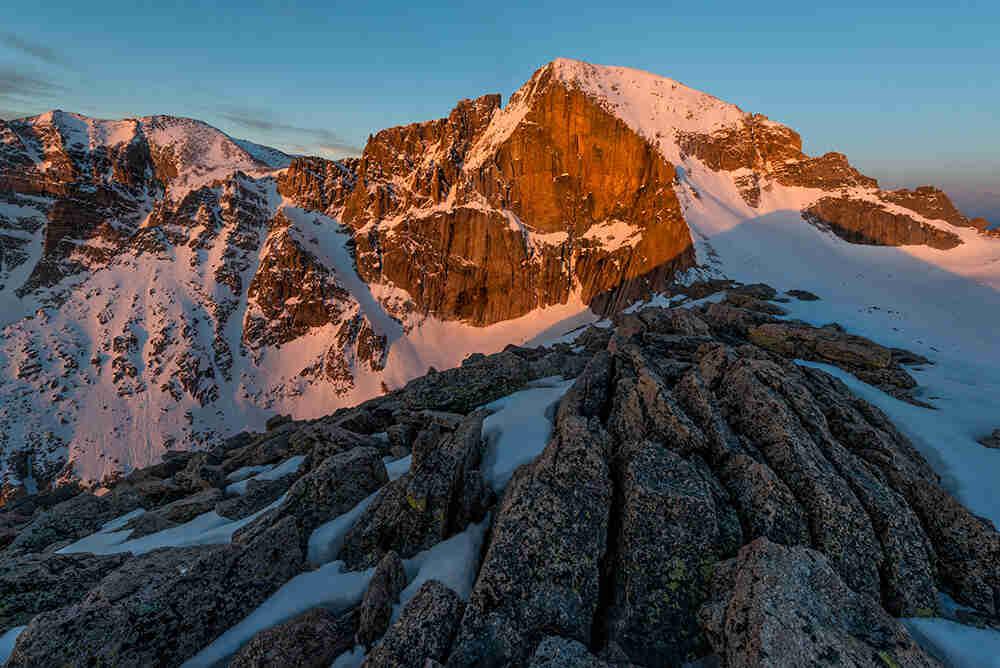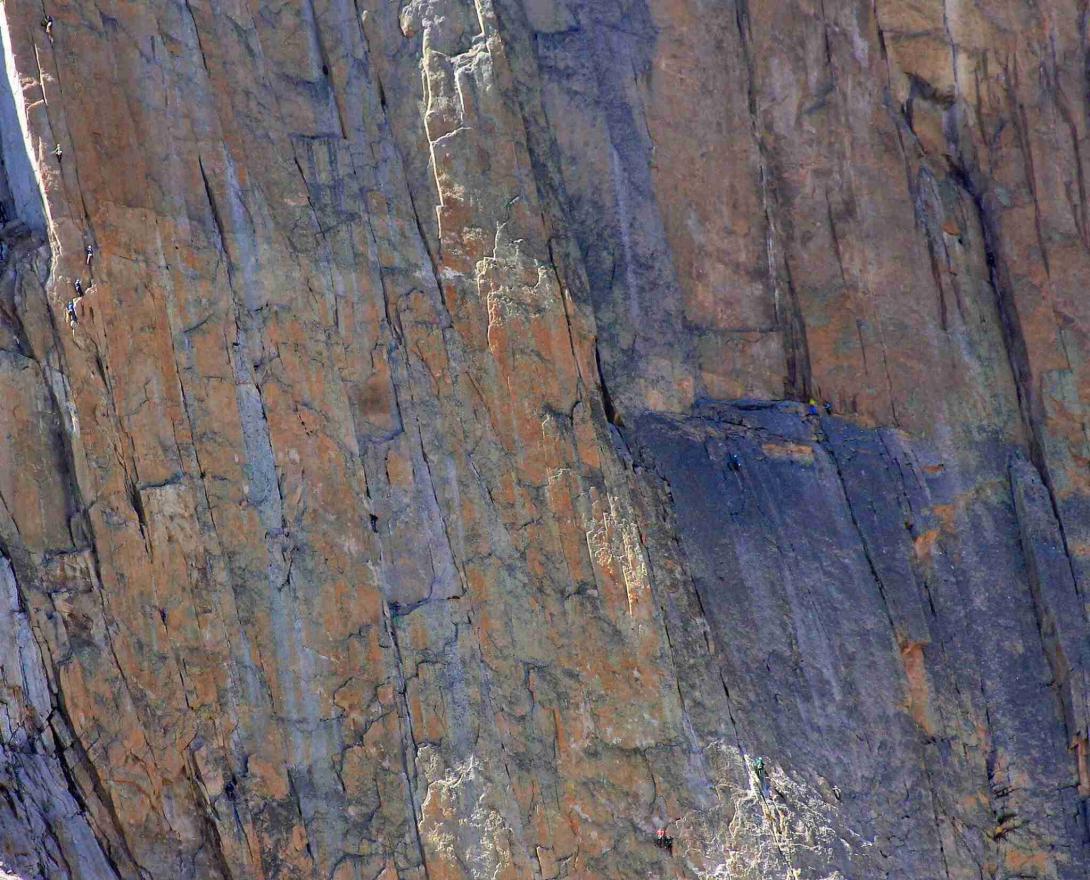Longs Peak
Full Article
Longs Peak is an icon of the Rocky Mountain landscape. At 14,259 feet, it is one of Colorado’s tallest mountains, the only Fourteener in Rocky Mountain National Park. For more than a century, the mountain has inspired adventuresome men and women to test themselves against its bouldered slopes, sheer rock faces, and alpine weather. The mountain was named for the American explorer Stephen H. Long, who led an expedition to the area in 1820. During the 1910s, the decade of Rocky Mountain National Park’s founding, hundreds of mountain enthusiasts climbed Longs Peak every year. Now, in the early twenty-first century, more than 30,000 individuals climb all or partway to the summit each year.
Protected Wilderness Site
Longs Peak’s status as a protected wilderness site makes it ideal for studying wilderness landscapes and their relationship to modern urban industrial society. The mountain gained federal protection because urban Americans came to believe that travel in undeveloped natural settings afforded them aesthetic, recreational, moral, and social opportunities not available in Denver and other fast-growing cities. Beginning in the late nineteenth century, America’s affluent city dwellers became champions of protected forests and parks, defining them as antidotes to the degrading effects of urban life.
Advocates hailed the virtues of the “great outdoors,” focusing on what humans could gain in newly protected areas rather than through natural resource preservation, which was little understood. While extolling the sublime and primitive experiences to be had at natural sites, visitors depended on modern conveniences to facilitate access to undeveloped areas. Recreational hikers and climbers have relied on modern technologies, services, and social networks. Railroads and airplanes; cars and roadways; hotels and restaurants; backcountry clothing, camping, and climbing gear; climbing guides, urban mountaineering clubs, and youth organizations – all of these have made travel to Longs Peak’s trailheads and summit possible. Visitors have also benefited from modern park management: marked trails and visitor information, shelter cabins and horse corrals, outdoor privies and emergency rescues. Indeed, backcountry adventure has become so accessible that Longs Peak’s East Trail, Keyhole Route, and summit have been too crowded during the summer months for most visitors to enjoy anything approaching wilderness solitude.
Modern technologies and infrastructure have not fully mediated the natural forces on Longs Peak. Visitors still face very real dangers in the alpine environment, and park managers expect climbers to assume responsibility for their own well-being. Recently, having acquired greater understanding of Longs Peak’s fragile ecology, park managers have also asked climbers to assume responsibility for the area’s environment and to leave no trace of their presence. Visitors rightly view it as an undeveloped wilderness site and one of nature’s finest creations, but it is also the product and emblem of an urban industrial society.
Rocky Mountain National Park
For generations, Longs Peak played a part in the seasonal migrations, hunting practices, and cosmology of Ute and Arapaho Indians. The Arapaho called Longs Peak and Mount Meeker the “Two Guides,” or nesótaieux, because of their physical prominence and role as landmarks for the entire region. After 1820, US surveyors, miners, traders, settlers, and soldiers gradually wrested control of the Rockies from native tribes and began turning Denver and other sites along the eastern edge of the mountains into an urban-industrial corridor. Tourism was one of the region’s emerging industries, and mountaineering was a recreational draw. A handful of Americans moved to the Estes Park area and carved out hardscrabble lives as climbing guides and hoteliers for a small number of tourists and climbers. As rail and automobile routes expanded and visitation increased, the wealth and ambitions of this rugged cohort grew apace. None was more important than Enos Mills, who moved to Estes Park as a young man, guided innumerable climbers to the Longs Peak summit on non-technical routes, became owner of the popular Longs Peak Inn, and campaigned tirelessly for the establishment of Rocky Mountain National Park. The park was founded in 1915, just one year before the National Park Service’s Organic Act assigned all national parks the task of balancing conservation and recreation. According to the act, parks must conserve “the scenery and the natural and historical objects and wild life therein” but must also provide “for the enjoyment of the same in such manner and by such means as will leave them unimpaired for future generations.”
In truth, visitor enjoyment rather than resource preservation drove priorities at Rocky Mountain National Park for many decades. From 1915 until the 1960s, park managers focused their attention on developing an accessible “front-country” within park boundaries. Paved roads, campgrounds, amphitheaters, wayside viewing areas, short nature trails, a ski resort, and a skating rink gave visitors ample opportunity to appreciate the park’s stunning landscape without great exposure to its natural dangers. Yearly visitation to the park rose steadily, from 31,000 in 1915 to over 1.6 million in 1965.
Reaching the Summit
Longs Peak remained a premier destination in the northern Rockies for alpine enthusiasts, even if it was not a focal point of park management. New roads and other amenities in and around the park eased climbers’ access to Longs Peak’s trailheads. The Colorado Mountain Club’s numerous chapters guided hundreds of members up the mountain each year. Climbers also came from across the country (and around the world) by rail and car and stayed in local inns or park campgrounds before stepping onto the East or North Longs Peak trails. Non-technical climbers followed these trails to the Boulderfield and then took the Keyhole Route to the summit. Over time, increasing numbers of technical climbers left the East Trail at Chasm Junction and sought the summit by way of Longs’ East Face, which included in its upper portion the sheer Diamond Wall.
Episodically, events at Longs Peak forced park managers to grapple with the exigencies of the backcountry. Thus, after thirty-five-year-old Agnes Vaille, an experienced mountaineer, died of hypothermia on the North Face in January 1925, Superintendent Roger Toll had to contend with the park’s responsibility for backcountry climbers. A climber and wilderness enthusiast himself, Toll opted for a system of limited intervention. Mountaineers remained largely responsible for their own well-being, but Toll ordered a partial rerouting of the East Longs Peak trail, the construction of emergency shelter cabins at Chasm Lake and the Keyhole, and the installation of steel cables on Longs’ North Face to assist climbers. In addition, he directed the construction of a shelter cabin (with telephone and horse barn) in the Boulderfield, to be run as a primitive hotel concession during the summer months. Finally, Toll assigned more park rangers to interact with visitors and educate them about the hazards and natural wonders of Longs. Toll hoped the park’s new system of limited management would increase climbers’ odds of survival while also encouraging them to behave responsibly and enjoy the peak.
Toll’s policy of limited intervention at Longs Peak went unchanged until the early 1960s, when a new generation of technical climbers with improved skills, new climbing equipment, and synthetic ropes demanded access to the Diamond Wall. Park managers initially rebuffed their requests but eventually relented, instituting a system of climbing permits. The park also improved its capacity for technical rescues and increased the presence of rangers. The growth of technical climbing, along with greater popular appreciation for wilderness in the 1960s and 1970s, had the perverse effect of increasing both natural resource damage and the risk of accidents on Longs Peak. Simultaneously, the passage of the Wilderness Act in 1964 increased the park’s responsibility for wilderness protection.
The park never discarded its tradition of leaving climbers largely responsible for their own well-being, but in an era of significant crowding and resource damage, more substantial interventions were required. The park dismantled the Cable Route in 1973 because it was deemed incompatible with the 1964 Wilderness Act. Beginning in the 1970s, park managers undertook scientific study of the natural ecology at Longs and elsewhere in the backcountry. Park managers also limited visitor access to backcountry campsites and areas with unmarked trails and began to educate climbers in minimal-impact ethics but chose not to limit the number of visitors allowed on Longs’ trails or summit. In the present day, climbers still hold primary responsibility for their safety and enjoyment on Longs, but they are now held morally responsible for resource preservation. And while Longs remains a massive peak in an unpredictable alpine setting, it also remains crowded during the summer months, a site of social interaction rather than wilderness solitude.
















